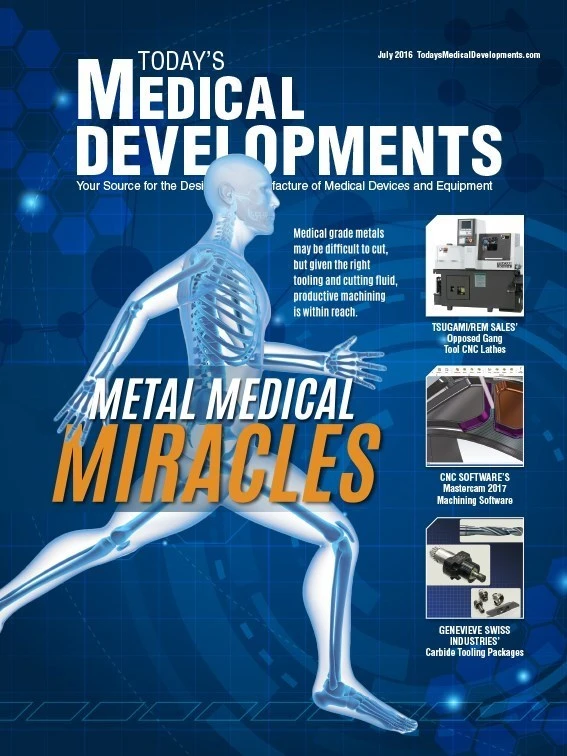
Part 2 of this three-part medical machining series from Sandvik Coromant takes an in-depth look at cutting tool selection for medical device metals.
Super strong metals that make jet engines spin faster, submarines dive deeper, and nuclear power plants safer to operate, are also responsible for most of today’s lifesaving implants and medical instruments. Heat resistant super alloys (HRSA) such as titanium and cobalt-chrome alloys comprise the lion’s share of bone screws, pins, fusion cages, and joint replacements; while trocars, shears, and hemostats made of 316L and other stainless steels – high in nickel and chromium – are common in any surgical theater.
These tough metals are biocompatible, fatigue and wear resistant, and very hard. And while these attributes make them desirable for use in the human body, they also present a variety of manufacturing obstacles, including poor and unpredictable tool life during machining. Sharp, positive-rake cutting tools and inserts are the rule when cutting titanium and other medical grade materials, but it takes the right blend of carbide, coating, and edge prep for tools to survive when battling HRSAs.
Plenty of choices

For finishing operations, Sandvik Coromant recommends a PVD-coated carbide such as 1105 grade – a multiphase TiAlN coating applied over a hard, wear-resistant substrate that resists cratering and abrasion while retaining the sharp cutting edge needed for effective machining. These types of PVD-coated tools also work well for the light depths of cut (DOC) and moderately high feedrates typical of the trochoidal, constant-engagement toolpaths used when roughing and semi-finishing HRSAs. Heavy roughing or interrupted cutting operations may require a tougher grade – a PVD-coated 1115, an uncoated H13A, or CVD-coated 2025 – all of which perform well against mechanical shock that is common when machining difficult materials.
Pocketing and slotting operations often benefit by using a roughing end mill designed for such work. Compared to the old-fashioned corn cob roughers most veteran machinists are familiar with, many solid carbide roughing tools are ground with varying pitch and helix angles to break up the harmonics that lead to chatter under heavy machining loads, while specially prepared flutes prevent edge chipping that is common when cutting tough medical materials. Don’t be scared off by what at first glance seems a steep price tag for these cutters – investment in high quality tools is the name of the game with HRSAs, and dropping an extra 25% (or more) for one that’s capable of Kung Fu-like cutting performance might be what it takes to turn a loser job into a winner.
One HRSA cutting tool option that may surprise some industry experts is ceramic. Known for extreme hardness and wear resistance, aluminum oxide and silicon nitride-based cutting tools have long been a favorite of the automotive industry for high volume machining of gray cast iron. But, these cutting tools are generally too brittle for superalloys. However, the addition of silicon carbide whiskers makes this material ideal for machining nickel-based materials, even under heavy roughing conditions. Silicon alumina nitride (SiAlON), for example, cuts cobalt chrome and similar super metals at speeds 20x to 30x greater than carbide. However, light feed rates must be used, generally less than 0.0039"/tooth (0.1mm/tooth), and round inserts are recommended due to SiAlON’s tendency to notch at the depth of cut line. Also, ceramic must be run without cutting fluid, and cannot be used to cut titanium due to chemical reactivity between the two materials.

Stick to the plan
These are all good starting recommendations, but unfortunately there’s no such thing as a general purpose carbide grade or cutting tool suitable for the entire range of HRSA machining. Shops can see significant productivity gains by working with a knowledgeable application specialist to fine tune their processes – someone with sufficient carbide grades and tooling geometries up his or her sleeve to cover the full spectrum of the shop’s materials and processes. The goal here should be development of a predictable tooling strategy rather than maximizing tool life or part output – better to change a cutter before it fails than to push too hard and scrapping out an expensive workpiece, or risk damaging an even more expensive machine tool.
Always perform test cuts on any new material, cutter, or machine tool to determine baseline feed rates, spindle speeds, and depths of cut. This may seem like a waste of machine time, but the effort is well worth it and helps maximize tool life and avoid scrapped parts. Follow the cutting tool manufacturer’s recommendations when starting out, but don’t be afraid to break the rules – if a certain insert grade is supposed to run between 300sfm to 600sfm with a chip load of 0.005ipr to 0.008ipr in titanium, go ahead and kick it up a notch if you’re getting good tool life, provided you can maintain predictable results. Pushing the boundaries is the best way to get ahead in this competitive machining environment.
Sandvik Coromant
IMTS 2016 Booth #W-1500

Explore the July 2016 Issue
Check out more from this issue and find your next story to read.
Latest from Today's Medical Developments
- Arcline to sell Medical Manufacturing Technologies to Perimeter Solutions
- Decline in German machine tool orders bottoming out
- Analysis, trends, and forecasts for the future of additive manufacturing
- BlueForge Alliance Webinar Series Part III: Integrate Nationally, Catalyze Locally
- Robot orders accelerate in Q3
- Pro Shrink TubeChiller makes shrink-fit tool holding safer, easier
- Revolutionizing biocompatibility: The role of amnion in next-generation medical devices
- #56 Lunch + Learn Podcast with Techman Robot + AMET Inc.





